‘A little world within a world’: The Wardian Case of Tropical Ferns in the Victorian Home
The history of the Wardian case – a glass enclosure that provided a microclimate for plants, particularly ferns – is bifurcated, as it had two distinct legacies. It is recognized as a crucial technological means to establish cash crops in colonial outposts of the British empire, which fundamentally changed ecosystems all over the world.[1] Victorians also adopted the Wardian case during the so-called ‘Victorian fern craze’ as a vehicle to display ferns and other plants in the domestic interior, a trend that reached its apex between 1850 and 1890 and aligned with a period of rapid expansion of the British Empire.[2] By examining the materiality of the case itself, the plants it contained, and Victorians’ modes of encountering it in their homes, I contend that these two seemingly disparate applications of the Wardian case are closely related.
Studies of pteridomania of the latter half of the nineteenth century – a moment in which interest in these plants ballooned – have largely tended to characterise the Wardian case in the home as a status symbol.[3] I argue that Wardian cases were not merely decorative, but were embedded within nineteenth-century discourses of cultivation, civilization, and ethnology. In this article I seek to uncover what ‘fugitive meanings of [these] apparently non-symbolic objects’, may have been legible to their owners.[4] I will argue that the Wardian fern-case in the Victorian drawing room was not only, as Thad Logan has suggested, a ‘home within a home’ but, instead, an empire within an empire.[5] The practice of maintaining Wardian fern-cases offered a safe outlet for middle-class Victorians to participate in empire-building at home. This article will demonstrate that the Victorian drawing room, conservatory, greenhouse, and garden were not, as John Ruskin argued, sanctuaries from the ‘inconsistently-minded, unknown, unloved, or hostile society of the outer world’, but rather sites in which the anxieties inherent within imperial expansion surfaced and were tested.[6]
Dr. Ward’s Case
Nathaniel Bagshaw Ward (1791–1868), a passionate collector of plants who practised as physician in the East End of London, developed the Wardian case by accident. In 1829, in an unrelated attempt to preserve a sphinx moth chrysalis in damp soil within a glass bottle, Ward noticed that a fern and some grass had sprouted within the vessel’s controlled environment. Noting that water cyclically condensed and evaporated within the bottle, he began a series of experiments in closely-fitted glass cases, which allowed air to circulate. The cases were not hermetically sealed, as many proponents mistakenly believed. Scholar Margaret Flanders Darby has recognized that Ward’s contribution was his observation of ‘dynamic equilibrium’ within a closed – but not sealed – container. Glass, a transparent, nonporous material, made this possible by facilitating photosynthesis (then understood as ‘vegetable assimilation’) while also providing a barrier to exterior environmental conditions. Ward manipulated the amount of light, volume of air, saturation of the soil, and other variables to cultivate varieties of ferns in different conditions within his home.[7] The case not only provided a micro-climate, but also protected the vegetation inside from the toxic, polluted air in the East End, which had previously poisoned Ward’s plants.[8] The influential landscape designer and gardening expert, John Claudius Loudon (1783–1843), visited Ward’s Wellclose Square home and declared that Ward’s glass cases transformed it, describing it as ‘the most extraordinary city garden we have ever beheld’.[9] Although Ward did not publically present his findings until 1842, when he published the first edition of On the Growth of Plants in Closely Glazed Cases, by the second half of the 1830s, his discovery had circulated within the scientific community.[10]
Ward’s collaborator, the Hackney nurseryman, George Loddiges (1786–1846), anticipated the case’s application in his own business. Through the first half of the nineteenth century, the Loddiges’ Nursery was a popular public site that eclipsed Kew Gardens, both in its accessibility and its application of technological innovations.[11] The case, which essentially provided a portable microclimate, represented a new vehicle to facilitate long-distance transportation of mature, living plants for the British market with minimal risk.[12] After Ward and Loddiges demonstrated that plants in Wardian cases could survive the journey from London to Sydney, Australia, the Loddiges’ Hackney Botanic Nursery Garden also adopted the Wardian case as a reliable means to import exotic plants from tropical climates.
Assured of the case’s success, the Royal Botanic Gardens at Kew and the East India Company also adopted a utilitarian model of the Wardian case and facilitated a series of botanical exchanges between the colonies of the British Empire and the wider world, which had seismic consequences for global ecology.[13] It transported tea seedlings from Shanghai to the Himalayas, bananas from China to Samoa (then to Fiji and Tonga), and rubber plants from Brazil to India, Sri Lanka, and Malaysia.[14] Thus, Wardian cases were the crucial technological means for the British government and corporations to introduce and establish natural resources – cash crops – in territories under colonial rule. Reflecting on the cases’ impact in a lecture at the Royal Institution in 1854, Dr Nathaniel Ward’s son, Dr Stephen Ward, asserted, ‘Sir W. Hooker bears ample testimony to the successes of the plan, and states that, in the space of three or four years, nearly 3,000 plants have been sent in these cases to our different colonial possessions’.[15]
However, Ward envisioned a domestic, therapeutic use for his cases; he hoped they could simulate the countryside by providing views to verdant foliage and vegetable gardens for his impoverished, city-dwelling patients. Ward argued that plants would physically improve their surroundings by ‘admitting far more light into the dwellings, continually purifying the atmosphere, and furnishing food to the mind as well as the body’.[16] Ward even recommended cases for mentally ill patients, citing one gentleman’s temporary recovery from ‘violent symptoms’ after a case of ferns was introduced to his treatment.[17] Still, although a Wardian case could be created in a variety of enclosed shapes and sizes, glass was both essential and cost-prohibitive. Ward personally petitioned to repeal the heavy taxes levied on glass, citing the potential benefits for the health of the poor.[18] Following the repeal of the Glass Excise Acts in 1845, manufacturing consumer products and architecture in glass – including greenhouses and conservatories – became possible and profitable.[19]
The Great Exhibition of 1851 in the Crystal Palace galvanized popular interest in these objects. Ward collaborated again with the Loddiges plant nursery and fellow fern-enthusiast, artist, and landscape designer Edward William Cooke (1811–1880) to present ferns that had been cultivated for years in the simplest variation of the Wardian case: glass boxes.[20] The cases were displayed in the transept of the Crystal Palace next to one of Hyde Park’s elm trees, which the architect, Joseph Paxton, had incorporated into the design.[21] Ward’s cases were categorized not as decorative objects for the home, but among ‘Philosophical, Musical, Horological, and Surgical Instruments’. The catalogue entry triumphantly rehearsed the success of Ward’s experiments and drew particular attention to the recent success of Robert Fortune, a botanist who clandestinely procured tea seedlings from China in Wardian cases on behalf of the East India Company.[22] Wardian cases were celebrated for ‘confer[ring] upon us a power of procuring exotic vegetable productions’ within the context of their service to the expansion of the British empire.[23] In this setting of the Crystal Palace, a Wardian case of ferns – technology that created and sustained a vegetative world unto itself – mirrored the building, a monumental architectural enclosure of glass that contained a microcosm of Britain’s global empire, in miniature.

Provisions for Pteridomania
Ward’s glass cases became principally associated with the first plants Ward himself cultivated within them – ferns. Wardian cases accelerated pteridomania by making possible the cultivation and observation of live specimens – from Britain and all over the world – in the comfort of the domestic drawing room. The cases could take many forms, such as a domed, bell jar (Fig. 1), an aquarium-like, trapezoidal container, or a steep-pitched, roofed container. Some gardening manuals encouraged readers to improvise their own at home.[24] Despite Ward’s efforts, the primary consumers of Wardian cases were upper- and middle-class Victorians, who could afford expensive imported plants and their accessories.[25] In parlours and drawing rooms, the cases were positioned on a table near natural light or embedded within the architecture of the window (Fig. 2). James Shirley Hibberd, a self-appointed authority on the home and garden, encouraged his readers to ‘have a stand expressly made for it, with four legs, of course, and an elliptical arch of fretted work to break the monotony of the straight lines’.[26] Wardian cases were so often populated by ferns, which were particularly suited to the case’s humid conditions and elevated temperatures, that they became popularly known simply as fern cases.[27] Cases out of direct sunlight could also provide the cool, damp conditions required for ferns native to Britain. In the second half of the nineteenth century, literature describing how to identify, harvest, cultivate, and preserve native and exotic ferns proliferated.[28] The motif of ferns was ubiquitous, appearing on household objects, from furniture to ceramics and greeting cards.[29]

Wardian cases of plants were part of a larger Victorian practice of bringing the natural world indoors through taxidermy animals, local shells, desiccated seaweeds, minerals, fossils, feathers, albums of pressed specimens, pots of plants, and aquaria of fish. They also collected, arranged, and appreciated the beauty of these objects as a romantic means of moral, educational, and spiritual uplift and, ultimately, a means of communing with God in celebration of Christian creationism. However, contemporary commentators insisted that the appreciation of ferns, in particular, demanded sophistication. One reviewer summarised the appeal and importance of ferns, writing:
Ferns are desirable luxuries, and those who cultivate a taste for them and similar objects seldom indulge in vulgar degrading enjoyments. The indulgence of refined taste may be expensive; its physics the purse, but it has a considerable influence upon the higher qualities of humanity: it is rarely combined with ignoble or unworthy pursuits.[30]
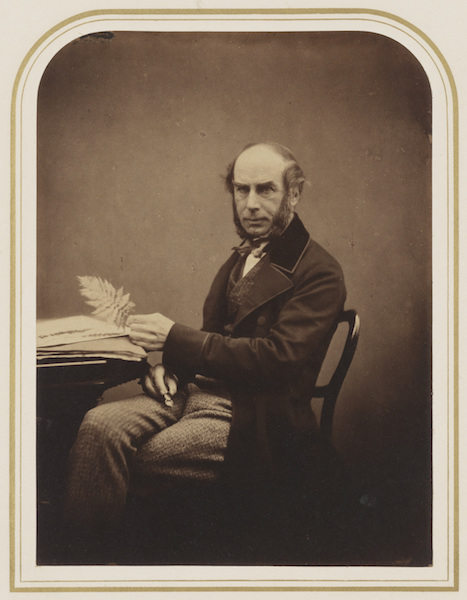
Botanists and natural history enthusiasts modelled an admiration for the elegance and refinement of ferns. Ferns are a consistent, recurring motif throughout The Literary and Scientific Portrait Club (1855–1858), a series of learned celebrity portraits produced by the commercial photography studio Maull & Polyblank, in which sitters were invited to bring items to represent their interests. Robert Hudson, a timber dealer, Fellow of the Royal Society, and Fellow of the Linnaean Society, whose collection of plants is held at the Warwick Archaeological National Historical Society, is shown holding a fern above the familiar hexagonal table, strewn with what appear to be botanical drawings of ferns (Fig. 3).[31] Thomas Corbyn Janson, a banker who ‘followed science chiefly as a recreation’ is depicted holding a fern, and another example rests on the covered table (Fig. 4).[32] At least four other sitters in the series chose to be photographed with renderings or specimens of ferns, which suggests that they were markers of erudition and status. Furthermore, these sitters – who were both amateur hobbyists and professionalizing scientists – also participated in the project of identifying, cataloguing, and collecting botanical specimens throughout the empire. For example, another sitter, Dr Thomas Thomson, who was photographed next to a selection of fern specimens beside a bell jar, travelled with John Dalton Hooker in the Himalayas, served as the superintendent of the Botanic Garden, Calcutta, and documented Indian flora in a volume he published with Hooker (Fig. 5).[33] R. Wakefield, who donated dried specimens he collected in Australia to the Linnaean Society, holds a fern in one hand and tools for magnification, the essential complement to a natural specimen, in the other.[34] Writing in his 1852 treatise, Ward confidently asserted that ‘a practised botanical eye can, with certainty, in almost all cases, predict the capabilities of any previously unknown country, by an inspection of the plants which it produces’.[35] Botanists, amateurs and professionals, were participants in the project of observing, valuing, and ultimately ranking the nature of the New World.
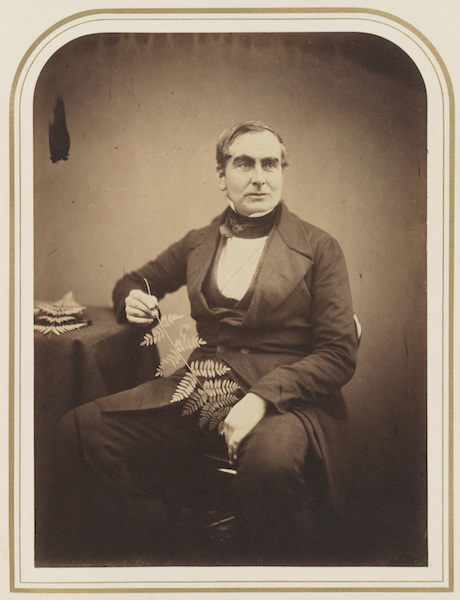
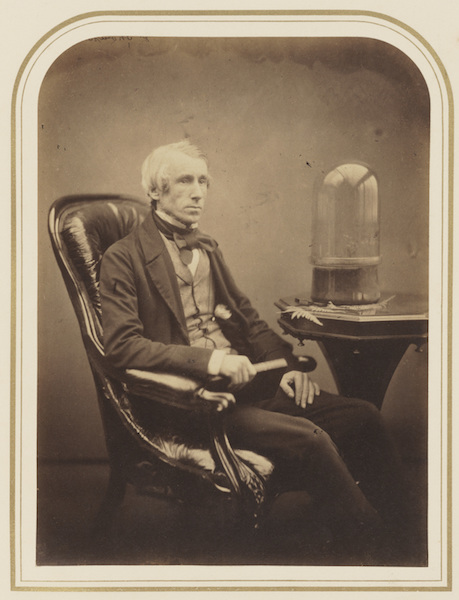
Containing the Tropics
In The Contest for the Bouquet (1866), Seymour Joseph Guy leverages the symbolism of the Wardian case to dramatize human dominance of the natural world through force and technological ingenuity (Fig. 6). The centre of the composition depicts a competition between siblings for a prize. The eldest brother, with schoolbooks in one hand, clutches in the other a handful of fresh flowers at arm’s length, out of reach of both his younger sister, who reaches elegantly (if ineffectively) and his mischievous younger brother, who, perched on a chair, lunges, in vain. Their youngest sister faces away from the scuffle in her mother’s lap. The matriarch of the family, angled toward the Wardian case, serenely observes the scene.
This family portrait highlights the discerning taste of the Gordon family as collectors of precious objects – paintings, silver, and ferns. The family’s collection of American landscape paintings are densely hung around the Wardian case and Renaissance-revival sideboard, which displays decorative objects in the tradition of kunstkammer and a selection of verdant ferns. Taken together, the objects in the Gordon family’s dining room project a sense of control over the natural world. The sideboard, one means for showcasing their collection, features references to the hunt: a sculptural carving of a boar’s head and what appears to be a low-relief carving of hanging game.[36] A pair of antlers preside over the dining room, occupy the centre of the composition, and serve as a material trophy for the victor in the mortal struggle between man and animal. The victor is the eldest son, who defeats his siblings corporeally by standing tall above them, and the books he clutches point to the significance of his intellect. The references to technology within the dining room – the gas chandelier on a system of mechanical pulleys and the Wardian case of lush greenery – underscore the ways in which natural phenomena of light and climate can be shaped to human will. It is within this context that ferns under glass are rendered as prizes of human technological conquest over the natural world.
The many varieties of ferns indigenous to Britain took on new meanings when set against so-called exotic ferns. Within late-eighteenth and nineteenth-century discourses on scientific exploration and colonization, imported plants, and ferns in particular, signified tropical nature. Naturalist-scientist-explorer Alexander von Humboldt (1769–1859), whose account of Venezuela, Colombia, Peru, and Ecuador set a precedent for describing the tropics through an exposition on its vegetation, was particularly fascinated by ferns, and remarked that ‘of all the vegetable forms between the tropics’ the tree fern was among the plants which ‘make the most powerful impression on the imagination of the traveller’.[37] Tree ferns resemble varieties that grow in Britain and continental Europe but for the trunks that elevate the fronds and their dramatic proportions. The so-called ‘exotic’ varieties available from the tropics and in the colonies of South Africa, Australia and New Zealand dwarfed familiar, miniature varieties of ferns available locally; some species of tree fern can grow to a height of over sixty-five feet. Margaret Plues, in her book Rambles in Search of Ferns (1861), vowed that although British ferns were ‘worthy of all honour’, ‘the fern valleys of Australia and New Zealand, where every plant is a forest tree, with such comeliness of form and lightness of foliage as fills the heart with admiring wonder… proudly uphold the [vegetable] family grandeur in the present age.’[38] Varieties of ferns signified the contrast between temperate and tropical climate, which engaged a broader set of dichotomies: ancient and modern, profusion and modesty, chaos and cultivation.[39]
Although imported tropical plants and ferns were natural – as opposed to mass-produced goods – they were consumer products, which were marketed as foreign imports. Nursery sales catalogues routinely listed the country of origin for every plant in addition to the scientific name and price. For example, the 1845 Loddiges catalogue of palms even omits the price, listing only the scientific name and nearly thirty individuated ‘native’ countries largely of the ‘New World’, from Jamaica and New Zealand to Ceylon. In the second half of the nineteenth century the commercial nurseries specializing in ferns, such as William and John Birkenhead, James Backhouse, Abraham Stansfield, William Farrow Askew, and H. B. May, continued to advertise ferns by the country from which they were originally harvested.[40] This insistence on communicating the plants’ source suggests that consumers identified and differentiated plants by their native country when they displayed them in their homes.
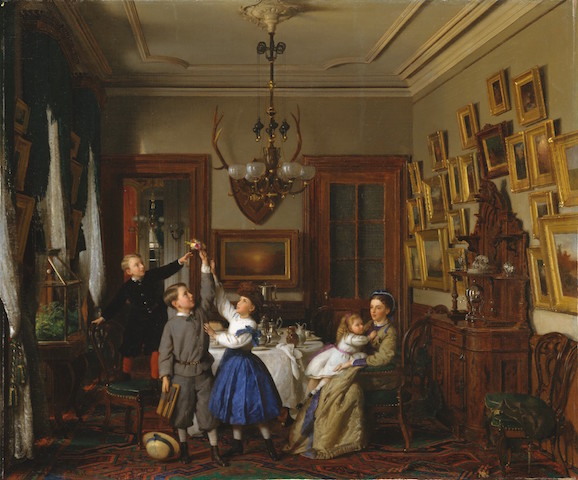
A Miniature World
Wardian cases and architecture in glass, including conservatories and greenhouses, brought the hot and humid climate tropical plants required to thrive into the Victorian home. Wardian cases were routinely described in relation to architecture as ‘miniature gardens or conservatories’, ‘miniature greenhouses’ or ‘plants in their miniature house’.[41] Like greenhouses, they were contained, freestanding structures within and outside the home, respectively. Conservatories, unlike the closed environment of the Wardian case, had permeable boundaries with the parlour and were embedded within – rather than contained apart from – the structure of the domestic environment. Often built as additions to a house, conservatories abutted existing living spaces on one side and were often separated by glass doors. To enter the conservatory, the divisions between the two spaces and climates collapsed, prompting fantasies and fears of intermingling tropical and temperate nature.
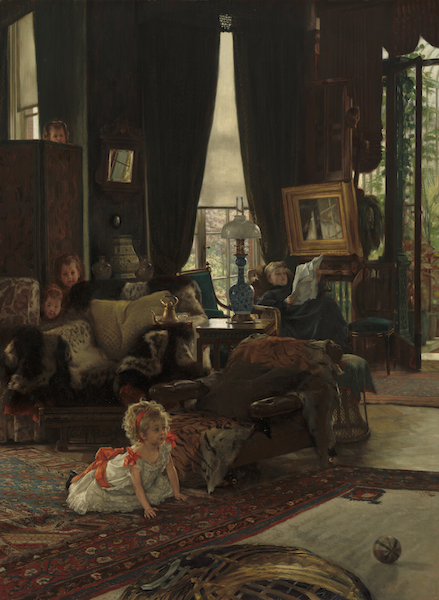
As Margaret Flanders Darby and Samantha Burton have shown, James Tissot (1836–1902) methodically investigated the contradictory metaphoric resonances of the conservatory as a site of pleasure and degeneration.[42] Tissot, who appended a conservatory to his own London home in St. John’s Wood, set several of his works in conservatories, including Hide and Seek (1877), The Convalescent (1872), The Bunch of Lilacs (1875), The Fan (1875), and In the Conservatory (The Rivals) (1875–1878). In Hide and Seek, an undercurrent of danger quietly unsettles a scene of domestic comfort in the liminal space between the parlour and the conservatory (Fig. 7). In a sumptuously appointed parlour, a group of children play hide-and-seek, while their adult guardian, Tissot’s romantic partner and model, Kathleen Newton, is absorbed in reading the newspaper. Three children peer from behind furniture as the youngest child surveys the room for signs of her playmates. In the direction of her gaze, a sliver of the conservatory is just visible and the door has been left ajar. Tissot dramatizes the unsettling relationship between play and danger, between wilderness and home, on the threshold between the domestic environment and the realm of the conservatory. The exotic animal furs, which surround the child at the centre of the composition’s action, recall the violent drama between predator and prey in nature that is playfully re-enacted in the parlour game of hide-and-seek. The natural world, which is brought into the home as animal furs and the plants in the conservatory, both creates and undercuts the comfort and security of the domestic sphere.
As Samantha Burton suggests, the widely held belief that the hot and humid air of the conservatory could be at the same time both beneficial to convalescents but dangerous to human health in excess amplifies the sense of tension and foreboding within Hide and Seek.[43] In the late 1870s and until her death in 1882, Tissot increasingly depicted Newton, who suffered from tuberculosis, as an invalid, confined to rest indoors.[44] Newton, who reclines in the corner with her newspaper, is ashen-faced and sickly in contrast to the blushing child at the centre. If the conservatory offered a fantasy of immersion that ultimately could carry the same pleasures and risks as travel to the tropics, the Wardian case offered a ‘climate within a climate’: an anesthetized alternative in which tropical plants could be contained, controlled, and surveyed indoors without mixing climates or threatening human health.[45]
Wardian fern-cases were an outlet for Victorians to imaginatively participate in the imperial project as a civilising force. John Stuart Mill, in his 1836 essay, explained that the term ‘civilization’ had dual significance:
It sometimes stands for human improvement in general, and sometimes for certain kinds of improvement in particular. We are accustomed to call a country more civilized if we think it more improved; more eminent in the best characteristics of man and society; farther advanced in the road to perfection; happier, nobler, wiser. This is one sense of the word “civilization”. But, in another sense, it stands for that kind of improvement only which distinguishes a wealthy and powerful nation from savages or barbarians.[46]
Thus, one interpretation of the Wardian fern-case was that it served as a metaphor for the ascendant nation Britain was building, where the owner ‘may blend with the beauties of his own land some of the more striking productions of the tropical regions’.[47] As the art historian Jill Casid has suggested, ‘the discourse of the picturesque intermixed landscape was also a discourse of race.’[48] Ferns, which grew in Britain and abroad, were particularly suited to illustrate the unity of the empire and stage the opposition between ‘native’ and ‘exotic’, between the ‘civilising’, temperate force of the British nation and the ‘savage’, tropical, ‘New World’, nature. Stephen Ward has written that:
The plants flourishing in their little world, in places where formerly they must have perished, may perchance lead him to reflect upon man’s controlling influence over the powers of Nature, may teach him that obstacles and difficulties are to be wrestled with, not yielded to, and may awaken in him a higher sense of his own capacities and dignity.[49]
The civilised considered themselves innately superior, and thus obligated to improve others. Owners of Wardian cases were encouraged to observe the ‘tribes of plants’ and ‘their quiet phases of development’.[50]
The Natural History of Mankind (1849), authored by Stephen Ward and published by the Society for the Promotion of Christian Knowledge, explicitly connects
contemporary ethnological theory, biblical creationism, and Wardian cases. In his text, which sought to demonstrate for a broad, popular audience ‘the evidences afforded by science, of the oneness of the human family’, Ward used fern-cases as a metaphor for global human diversity.[51] When explaining how variation among species occurs, he refers directly to Wardian cases of ferns, writing: ‘We have in a fern-case, at the window of the study in which we are writing, specimens of the Hart’s tongue, and also of another fern, which are constantly sending out fronds deviating from the natural form’.[52] Varieties of ferns, illustrated within the text by Edward William Cooke, were a particularly apt symbol for the mystery of human diversity in an age when new species of the plant were being discovered, particularly in Australia, at an unprecedented rate (Fig. 8).[53]
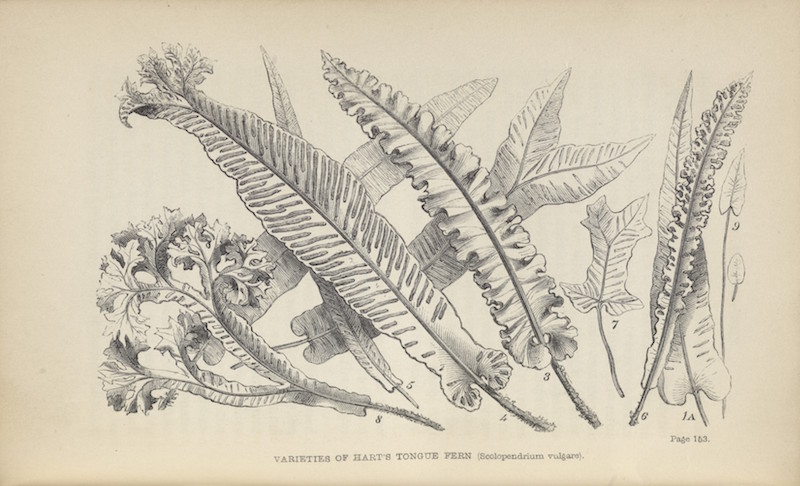
Made of glass, the material symbol of British industrial, scientific, and civic progress, Wardian fern-cases allowed Victorians to create and observe this ‘civilising force’ on tropical nature. Ultimately, however, complete control over nature through glass was a fantasy. Even in the new Palm House at the Royal Botanic Gardens at Kew, a greenhouse which was engineered to accommodate tropical trees, violence against the vegetation was constantly required to prevent them from destroying the infrastructure. Less than two years after its completion in 1848, a palm tree outgrew the glass space in which it was enclosed.[54] In 1863, two precious trees, which put pressure on the glass roof, were killed and discarded.[55] Another valuable tree suffered a similar fate in 1876.[56]

When the greenhouse is miniaturised and domesticated as a Wardian case, it allayed these anxieties by creating a space where conflicts between industry and nature, civilised and savage, Britain and the ‘New World’, were neutralised. The fern under a miniature glass canopy in a Wardian case, registers this desire and communicates the possibility of total authority over tropical nature. At the Palm House at Kew, visitors were dwarfed, engulfed, and conquered by the profusion and scale of vegetation (Fig. 9). Such unsettling relationships in scale are reversed in the drawing room’s Wardian fern-case. The possessor of ferns in the Wardian case had an all-encompassing, total view from above; the world contained therein comprised of specimens known, named, and owned. Indeed, Wardian fern-cases illustrate the aspirations of Victorians to not only control, but create and survey this ‘little world within a world’.[57]
Far from serving as simple decoration, Wardian fern-cases offered a crucial outlet for bolstering a British imperial identity at home. Varieties of native and exotic ferns signified of their countries of origin and allowed Victorians to imagine a rapidly transforming imperial landscape and blended empire. Hibberd succinctly summarised not only these ambitions, but also the anxieties the Wardian fern-case, writing in the preface to his Rustic Adornments for Homes of Taste (1856), ‘If we have arrived at the culminating point in our civilization, we may yet feel some assurance that as long as luxury takes such innocent shapes as it now begins to delight in, our descent towards the horizon is certainly far off’.[58]
Citations
[1] Lucile Brockway, Science and Colonial Expansion: The Role of the British Royal Botanic Gardens (New York: Academic Press, 1979), 87, 141.
[2] David Elliston Allen, The Victorian Craze: A History of Pteridomania (London: Hutchinson, 1969), 28; Sarah Whittingham, Fern Fever: The Story of Pteridomania (London: Frances Lincoln, 2012), 35.
[3] Studies of pteridomania include: Allen (1969); David Elliston Allen, ‘Tastes and crazes’, in N. Jardine, J. A. Secord, and E. C. Spary eds., Cultures of Natural History (Cambridge: Cambridge University Press, 1996), 394–407; David Elliston Allen, ‘The Victorian Fern Craze: Pteridomania Revisited’, in David Elliston Allen ed., Naturalists and Society: The Culture of Natural History in Britain, 1700–1900 (Aldershot: Ashgate, 2001), 9–19; Whittingham.
[4] Elaine Freedgood, The Ideas in Things: Fugitive Meaning in the Victorian Novel (London: University of Chicago Press, 2006), 4.
[5] Thad Logan, The Victorian Parlour: A Cultural Study (Cambridge: Cambridge University Press, 2001), 157.
[6] Deborah Epstein ed., Sesame and Lilies, (New Haven: Yale University Press, 2002), 77. See especially Samantha Burton, ‘Champagne in the Shrubbery: Sex, Science, and Space in James Tissot’s London Conservatory’, Victorian Studies, 57, 3 (Spring 2015), 476–489; Logan, 140–161; Rebecca Preston, ‘“The Scenery of the Torrid Zone”: Imagined Travels and the Culture of Exotics in Nineteenth-Century British Gardens’, in Felix Driver and David Gilbert eds., Imperial Cities: Landscape, Display and Identity (Manchester: Manchester University Press, 1999), 194–211.
[7] Margaret Flanders Darby, ‘Unnatural History: Ward’s Glass Cases’, Victorian Literature and Culture, 35, 2 (2007), 637.
[8] J. D. Hooker, ‘Nathaniel Bagshaw Ward, F.R.S., F.L.S.’, The Gardeners’ Chronicle and Agricultural Gazette (Published 20/6/1868), 655.
[9] ‘Growing Ferns and other Plants in Glass Cases’, The Gardener’s Magazine (Published 04/1834), 162.
[10] N. B. Ward, On the Growth of Plants in Closely Glazed Cases (London: John Van Voorst, 1842).
[11] Ray Desmond, Kew: The History of the Royal Botanic Gardens (London: The Harvill Press, 1995), 159–160.
[12] David Solman, Loddiges of Hackney: The Largest Hothouse in the World (London: The Hackney Society, 1994), 44.
[13] Brockway, 86–87.
[14] Brockway, 87, 141.
[15] Stephen H. Ward, On Wardian cases for plants, and their applications (London: John Van Voorst, 1854), 19.
[16] Ward (1854), 93–94.
[17] Ward (1854), 16.
[18] N. B. Ward, On the Growth of Plants in Closely Glazed Cases, 2nd ed. (London: John Van Voorst, 1852), viii.
[19] An Act for Granting to His Majesty Several Rates and Duties upon Glass, and upon Spirituous Liquors; and for Raising a Certain Sum of Money by Annuities, and a Lottery, to be Charged on the Said Duties, 1746 (19 Geo. 2 c.12). Repealed by An Act to Repeal the Duties and Laws of Excise on Glass, 1845 (8 & 9 Vict. ch. 6) §1.
[20] ‘Wardian Cases’, Illustrated London News (Published 2/8/1851).
[21] Ward’s cases were illustrated in the foreground of ‘The Great Exhibition. — The Transept, Looking South’, Illustrated London News, (Published 19/7/1851).
[22] See also Robert Fortune, Two Visits to the Tea Countries of China and the British Tea Plantations in the Himalaya, vol. 2 (London: John Murray, 1853), 98, 275, 287–288, 291.
[23] ‘Wardian Cases’, Illustrated London News (Published 2/8/1851).
[24] See, for example, John R. Mollison, The New Practical Window Gardener (London: Groombridge and Sons, 1877), 127.
[25] Allen (1969), 28.
[26] Shirley Hibberd, Rustic Adornments for Homes of Taste, 2nd ed. (London: Groombridge and Sons, 1857), 139.
[27] See, for example, Henry T. Williams ed., Window Gardening Devoted Specially to the Culture of Flowers and Ornamental Plants for In Door Use and Parlour Decoration, 6th ed. (New York: Henry T. Williams, 1873), 160.
[28] Whittingham, 35. See also Nigel Hall and Martin Rickard, Fern Books and Related Items in English before 1900 (London: The British Pteridological Society, 2006).
[29] Whittingham, 173–188.
[30] ‘Review: A Priced Catalogue, with brief descriptive and cultural remarks of the extensive collection of Stove, Greenhouse, and hardy Exotic and British Ferns, grown for sale by Robert Sim, Nurseryman, etc. Foot’s Cray, S.C., Kent’, The Phytologist, (May 1860), 159.
[31] Desmond (1994), 362.
[32] ‘Obituary Notices — Mr. Thomas Corbyn Janson’, Proceedings of the Linnaean Society of London (1863), xxix. See also Ray Desmond, Dictionary of British and Irish Botanists and Horticulturists (London: Taylor and Francis, 1994), 380.
[33] Desmond (1994), 682. See also Joseph Dalton Hooker and Thomas Thomson, Flora Indica: Being a Systematic Account of the Plants of British India, Together with Observations on the Structure and Affinities of their Natural Order and Genera (Cambridge: Cambridge University Press, 2011).
[34] ‘Donations to the Museum of the Linnaean Society’, Transactions of the Linnaean Society of London 21 (1855): 351.
[35] Ward (1852), 14.
[36] See Kenneth L. Ames, Death in the Dining Room and Other Tales of Victorian Culture (Philadelphia: Temple University Press, 1992), 44–96.
[37] Alexander von Humboldt, Personal Narrative of Travels to the Equinoctial Regions of America, During the Years 1799–1804, vol. 1 (London: Henry G. Bohn, 1852), 217.
[38] Margaret Plues, Rambles in Search of Ferns (London: Houlston & Wright, 1861), 14.
[39] Felix Driver and Luciana Martins, ‘Views and Visions of the Tropical World’, in Felix Driver and Luciana Martins, eds., Tropical Visions in an Age of Empire (Chicago: University of Chicago Press, 2005), 3.
[40] Peter Davis, ‘James Backhouse of York (1794–1869): missionary, traveller and botanist’, Archives of Natural History, 16, 3 (1989), 256; N. A. Hall, ‘W. and J. Birkenhead: “Ferns a Specialty”’, Garden History 11, 1 (Spring 1983), 79–80.
[41] ‘Growing Ferns’, 163; Mollison, 124; Edward Sprague Rand, Jr., Flowers for the Parlor and Garden (New York: Hurd and Houghton, 1876), 235; Edwin A. Johnson, Winter Greeneries at Home (New York: Orange Judd Company, [1878]), 90; Annie Hassard, Floral Decorations for the Dwelling House: A Practical Guide to the Home Arrangement of Plants and Flowers (London: Macmillan & Co., 1875), 118.
[42] Margaret Flanders Darby, ‘The Conservatory in St. John’s Wood’, in Katharine Lochnan ed., Seductive Surfaces: The Art of Tissot (New Haven: Yale University Press, 1999), 161–184; Burton, 476–489.
[43] Burton, 486.
[44] Christopher Wood, ‘Kathleen Newton’, in Jill Berk Jiminez ed., Dictionary of Artists’ Models, (London: Fitzroy Dearborn, 2001), 400.
[45] Ward (1854), 11.
[46] John Stuart Mill, Dissertations and Discussions, Political, Philosophical, and Historical, vol. 1 (Boston: William V. Spencer, 1865), 186.
[47] Ward (1854), 12.
[48] Jill H. Casid, Sowing Empire: Landscape and Colonization (Minneapolis: University of Minnesota, 2005), 15.
[49] Ward (1854), 13–14
[50] Ward (1852), 7; Ward (1854), 26.
[51] Stephen H. Ward, The Natural History of Mankind (London: Society for Promoting Christian Knowledge, 1849), 206.
[52] Ward (1849), 153.
[53] Whittingham, 27.
[54] Desmond (1995), 368.
[55] Desmond (1995), 166.
[56] Desmond (1995), 230–231.
[57] Ward (1854), 13.
[58] Hibberd, iii.





